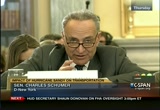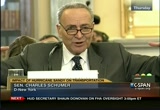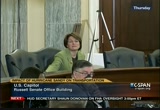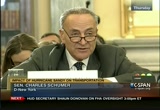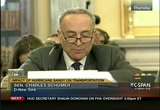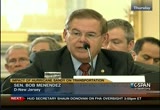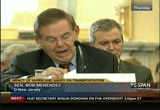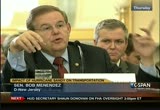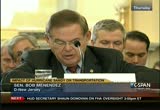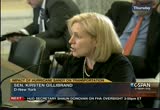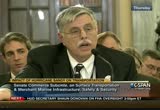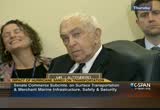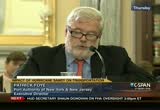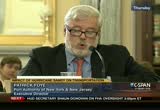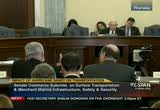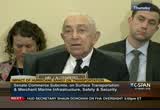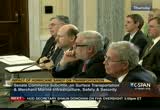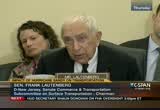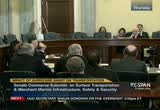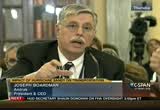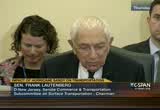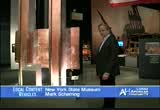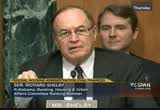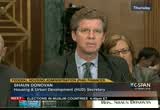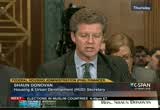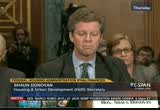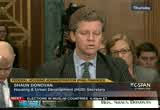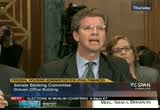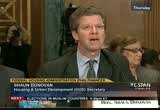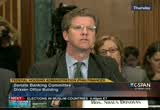tv Washington This Week CSPAN December 9, 2012 2:00pm-3:55pm EST
2:00 pm
appreciated by us. we're also glad in a certain sense -- not that you suffered the me damage, but you understand what we're going through because of the devastation that katrina wreaked on your community. of course to have my friend, bill nelson here, who, as he said, lives with hurricanes as a way of life, we're learning how tough it is. and we have renewed sympathy for the people of florida and the gulf coast who live with these things regularly. new york state, as you know, suffered nearly $7.3 billion in transportation-related damages due to superstorm sandy. of that total, the new york mta suffered about 5 billion in dages. it's huge. i never saw anything like it. we have the longest underground tunnel in the world in the brooklyn battery tunnel. i take it almost every day i'm in new york city because my home
2:01 pm
in brooklyn is connected to it. it was totally filled with water. both tubes, from one end to the other, from the manhattan end to the brooklyn end. ere were close to 100 million gallons of water that had to be pumped out of that tunnel and it's still not back up to snuff. that's one of many examples. there's so many. the mta did a very good job. i want to congratulate joe lhota. they moved their rolling stock to high ground. tried to barricade this awful flood in the best way they could. boy, it's awful. the mta is the largest public transportation system in the country. it's the life blood of new york. it's our circulatory system. 3.5 million people g on and off manhattan island every day to work. wow. 3.5 million people. i guess that's more than the people in mississippi and probably more than the people in dade county, any way. and we depend on it. 2.63 billion trips a year.
2:02 pm
as i said, the mta took a lot of necessary precautions. but this is 108-year-old system. it's the first major subway system in america. and it was never subject, as you noted correctly, senator nelson, with the full moon, the high tide and the huge storm. never hadnything like this. the mta tried to put up barriers. in many cases they worked. in other cases like the beautiful and new south ferry station right near the world trade center, the barriers re just knocked over by the high winds and flying debris. this one subway station, south ferry, is going to cost over 00 million, nearly 600 million to repair. many more underwater tunnels that connected the systems together gone. saltwater, which, of course, is corrosive to the switches, tracks and everything else. there's lots of permanent
2:03 pm
damage. the system is still not running up to snuff. there's two points i would like to make to this committee. the first, we need help with mitigation. we can't just rebuild a 108-year-old system andeplace it with the parts that existed then. most of then don't exist anymore, and it doesn't make much sense to redo it exactly as it is, god forbid if there's another flood like this. we need help with mitigation to make it stronger and better. i know senator wicker understands this. i think it passed by one vote, i was that vote in the well of the house when he and thad cochran came to me, they had to move a freight line away from the floodplain in mississippi. it cost close to $1 billion. we understand the need for mi mitigation now. you can't replace what has been damaged. even if you could, you wouldn't
2:04 pm
want to. you want to make sure the next storm that occurs, now th we're so much the wiser, senator nelson, we wanted to make sure we're much more flood-proof. so we're going to need all kinds of things. inflatable plugs, station seals at vulnerable points should be part of the federal propal. so, first point, we need help not just in replacement but in mitigation. it only makes sense in a large, old but vital system like this. second point, we need some flexibility, which is related. and the good news is that we have in a vehicle that's available that is the public transportation emergency relief program, fema has done a good job by in large. there are lots of mistakes, but fema is doing its best under difficult circumstances. but they're not expert on transportation. and marry landeu told us down in the gulf area it was much
2:05 pm
better to deal with the federal transportation administration, which would be dealt with if we put money into the public transportaon emergency relief program. it's an authorized program. we did it last year in the transportation bill, but the cupboard is bare. there's no money in it. we all understand that under the stafford act we get these dollars, the mt is a public system. it would be much better to put it under fta. theublic transportation emergency relief program. because they provide grants to states and public transportation systems to protect, repair and replace equipment that's been damaged by a natural disaster, but congress created this program to create flexibility. despite what fema has tried to do iour localities, fema is bound by the law to replace things to a previous condition, and that doesn't make sense. the combination of having
2:06 pm
mitigation monies and doing it through the emergency relief program, transportation messa emergency relief program makes sense. new orleans was forced to buy old buses. that made no sense. we need flexibility. that's why we need an fta emergency relief account. bottom line in conclusion, new york has no choice. we have to simultaneously rebuild and adapt to protect against future storms. we are a waterfront region. new york and new jersey is a waterfront region. it's bome clear we're in the path of violent new weather realities and we have to adapt. i want to thank the chair and the committee for the opportunity to speak. >> thank you very much, senator schumer. senator menendez? >> thank you, mr. chairman. i particularly want to say that your leadership in this committee and the appropriations
2:07 pm
committee is going to be so critical to the reconstruction of new jersey and we appreciate not only your leadership in those position but the leadership you've shown alongside those of white house are trying to restore the lives of new jerseyans. so you're critically important to our collective success for the region. i appreciate the comments of the ranking member, senator wicker and nelson, as someone who has stood with the people o mississippi and florida each and every time there's been an issue of devastation and recovery, i'm heartened to hear the remarks that you both made, because it's critically important to the people of new jersey now. we don't have that experience. this is the first time we had the experience. i lived in the state my whole life, i have never seen the b d bredth and scope of devastatn.
2:08 pm
i appreciate to give one or two dimensions of that. there are many, but for the purposes of this hearing. the numbers are staggering across the region. we lost 34 lives during the storm. it was the largest mass transit disaster in our nation's history, in our nation's history. 4 out of 10 of the nation's transit riders, of the nation's transit riders had their commutes disrupted by the storm. many of them still do today. new jersey transit alone had dozens of locomotives and railcars damaged in the flooding. miles and miles of tracks daged. the preliminary damage estimate is now up to about $37 billion. we are getting more damage numbers, but the total toll transportation and commerce is truly incalculable. the port of new york and new jersey, most of it is on the new jersey side is the mega port of the east coast. 250,000 jobs, 25 billion to $30
2:09 pm
billion of economic activity for the nation suffered widespread damage. ships were unloading during the course of the storm, b a full recovery from the damage caused on theorts will take much longer. the storm surge grew to 14 feet, winds were about 90 miles per ho, pore than 700 cargo containers were damaged when the surge and high winds toppled the containers on to another. in thispicture, you can see half of the rt authority barge was lifted on to a berth in red ho hook. in jersey cy, a float was used to move railroad cars broke in half. 150 feet of railroad track was washed away. cargo handling cranes and other pieces of equipment were severely damaged. this is also important to national security issues, in the
2:10 pm
last background, the only port in bayonne, new jersey was closed, so the use of commercial port for forward projection for the east coast is the port of new york and new jersey. when it cannot operate, it's part of a national security imperative as well. the trucking industry lost about 1,000 rigs to flooding at the port and other locations where they were parked which is about 25% of all of the truck fleet that serves the port region. about 16,000 cars were destroyed. total loss in the tangled mess of colored met scraps is a mix of cars and hundreds of motorcycles destroyed by the storm. over 50 ships were diverted that were headed for new york and new jersey. those ships were carrying over 15,000 cargo containers and almost 10,000 automobiles. that's just one dimension. as far as other transportation damage up and down the new jersey coast, the sheer scope of
2:11 pm
the damage is difficult to fathom. this next pictures the bridge that crosses barnegat bay and crosses brick with mantoloking this is how some of the greatest destruction of the homes in that region. amazingly the bridge can be repaired, but many of the surrounding homes were lost, part of that highway will need to be rebuilt. this next picture is a shipping container where -- and a large pleasure boat crossed on to the morgan rail bridge on the north jersey coastline along with tons of debris, obviously killing a main artery of the state's riders. it took a lot of work to restore service on new jersey transit which suffered disruptions on every rail line. even today, as we speak, the port authority's path terminal, the subway between new york and
2:12 pm
new jersey under the hudson river is inoperable and will not be back on line for some time. those are tens of thousands of riders every day that are effected and obviously not only their commutes but the cost of their commutes is dramatically growing in theidst of a challenging economic time. corrosive sea water rushed into the path stations at exchange place in hoboken a the hoboken station may still not be reopened for weeks. so, mrchairman, that's one dimension on transportation. we lost thousands of homes. we have thousands of people who are out of a home. i'm not talking about a second home. many people think about the new jersey shore and they think that's about second homes. no, these are year-round communities where people have made their lives and their investments and now seen it wra washed away. they don't have a place to come back home to.
2:13 pm
th's why it's critically important, the work of this committee and to ask our colleagues as we have stood with the people of the gulf coast and hurricane katrina and in florida, the people of joplin, missouri after a tornado ravaged their community, when the mississippi flooded, when crops were destroyed in the midwest, we have been there. since this is the united states of america, we need you to be with us. >> thank you very much, senator menendez. senator gillibrand, relatively new here, but in real fighting form whenever it comes to the needs of ourregion and your state, obviously. we're pleased to have you here. please, ur testimony. >> thank you, mr. chairman. thank you committee members for attending today. you know better than anyone, mr. chairman, how sere this storm was and the type of destruction that was wrought throughout new
2:14 pm
york, new jersey, connecticut. we are still suffering gravely. there are still families that cannot return to their homes. there are businesses in the early stages of figuring out how to rebuild. the were so many lives lost so many families torn apart. i can tell you this is the job of the federal government. it isur job to protect people. it is our job to help communities rebuild when there are natural disasters that local governments just can't afford to be able to pay for on their own. now, new york has been working very hard to come up with a plan about how to rebuild. but the transportation infrastructure has taken an unbelievable beating. in new york alone, 2,000 miles of roads were destroyed or damage 11 tunnels were flooded. and our -- our city and our state really relies on mass transit. we are the number one users of
2:15 pm
mass transit in the country. and with our mass transit system, miles of tracks and tunnels were flooded with corrosive saltwater. 12 subway ations were damaged or destroyed, 500,000 transit riders are still experiencing severe disruptions. you will have the mta chairman come in which is fantastic. he can give you the nuts and bolts of the loss, the repairs, a lot of service is up and running now, b long-term repairs must be done. the storm just filled up the subways. when we builthese subways 100 years ago, they could not have imagined this kind of flooding or storm. so the water just rushed in that corrosive saltwater did effect the electrical systems and the ability to get the stations back up and running. it's a massive undertaking. the initial estimates are that just fixing our mass transit system could cost about $5 billion. you can see the extent of the
2:16 pm
kind of damage and how much it really takes to do. this is our rail system. these are the rockaway track the tracks are just washed out. so, if you notice about the geography of new york state and new york city, we have rail lines coming in and out of new york state, straight up, straight west, straight east, they are essential for new yorkers to get to work. new york city is a city of 8 million people, but millions come into new york city every day by road or by rail. that's the kind of work that needs to be done just to get our city up and running again. i won't give much more detail, he rely on the testimony that's been given previously and the testimony that is to come. but i just want to emphasize for our colleagues, the reason why these hearings matter is because the rest of congress, the rest of the senate has not necessarily been to new york since the storm. they haven't seen the devastation in these
2:17 pm
communities. they have not seen the destruction caused to so many families so many businesses. you know, we've seen storms before. we've seen storms across the country. we've seen wildfires, tornados. we saw what happened with hurricane katrina. so we know what suffering looks like. and i can tell yo new york has never suffered on this level because of a natur disaster, ever. so to have the abity and wherewithal to bin to rebuild will mean that we will rely on the federal government. so i wanted to thank you for holding this heari. i want to thank you for giving us the opportunity to tell these stories and show you what really happened in new york. thank you. >> thank you very mu. senat senator klobuchar, you requested an opportunity for a statement. >> i wanted to thank all four of you, mr. chairman as well as
2:18 pm
senator menendez, senator schumer, and i specifically talked to senator gillibrand at length about this. i know having some version of this in minnesota with flooding in the red river valley, and everybody remembers grand forks, we had similar close calls with fargo and moorhead, what this is like for the families. i appreciate how yourought this home to us in terms of the effects of people. what i remember is new york state and new jersey and the rest of the country stood by minnesota and north dakota when we had our severe weather and our severe floods, or when the 35w bridge collapsed. we were able to rebuild that bridge within a year. we saw firsthand what that was like to have a major infrastructure destruction within our city. it's important during a time of divisiveness that we sta together and stand for those effected by this horrible storm.
2:19 pm
i do know that our minnesota national guard has been out there. we consider them the best guard in the country, senator gillibrand, mr. chairman. they've been out there helping. and i think that's just much of the spirit that we bring here. and we all have to understand that just as importantly as giving those emergency supplies to people, 're now at the next stage. we are at the stage of we building. rebuilding means rebuilding infr >> next, we will hear testimony from the head of amtrak and new jersey transit. this is about 45 minutes.
2:20 pm
>> we know that you have so much on your hands. the one thing i want to make sure it's -- make certain we understood is the magnitude of the support teams that came in from all over the country. the fact that it took some time to get things going. the devastation was so enormous that when we look back, a lot was done in a relatively short time. you each have major
2:21 pm
transportation responsibilities and we are glad to have you as experts testifying so you can keep your statements within five minutes, we will allow you a couple of seconds, but otherwise, i would ask you do that. did it amtrac get a new name? what are we calling the organization? >> the infrastructure and a investment development line for the northeast?
2:22 pm
the official title? >> good old and track. >> america's railroad. >> i would like to acknowledge the deputy transportation -- dead -- that before transportation. we have testimony and i would ask that the place in the record. coming from where each of you has had to be in the past weeks, i know there has to be a enormous frustration and
2:23 pm
heartbreaks in what you have seen and how each of you understand. what is the penalty for having systems that cannot operate or for having used judgment and reaction to the storm and i think good decisions, we will explore them a little bit just to see what we can find out. the president and ceo of amtrak talked about the damage to amtrak correctly and how we can protect our rail system in the future. >> thank you for your support of amtrak for some years.
2:24 pm
we understand what you do and but we thank all of the senators here. i will be very brief. it also impacts both other senators here. senator weicker, your city of new orleans and the crescent service was unable to complete their trips because of what happened in new york city. they could not make the transfer, no matter what the case was to get to new york city and this was a time of year when as families scattered across the country are bonded by the ability of amtrak to move them. that is not something that is captured here. when we look at what we lost in terms of revenue, we are about $30 million just in terms of the few days we were out of business. direct costs to get things fixed was another $20 million.
2:25 pm
you'll hear the smallest numbers in terms of our actual cost to deliver us. initially, what we understood is we were going to have a tale of impact of reduced revenues and that has not happened. one of the reason is that has not happened is the real story here is the coordination and cooperation of the leadership that got together and it is about the men and women of amtrak, new jersey transit, the mta, and the port authority which delivered a no-nonsense delivery of services for the future. we had four of the seven tunnels in new york plug with water. we had the electric system inundated by saltwater, which meant we still have difficulty making those kinds of improvements. then we had the electric plant
2:26 pm
that did not give us enough power to move the trains in and out of new york. but the real story for us to get done as quick as we did and before the end of october, we were returning service and even by the third of november, we had boston service back. was the fact that we had funding that we used after the lessons we learned in 2011 -- in life safety and health and those helped us pump up the tunnel. if those had not been here, we would be talking not just days but weeks before we returned service to new york city. the right decision was made to invest. we took recovery funds and began to clear our right of ways early. we only had a the trees on our right away which allowed us to move things much quicker.
2:27 pm
investments -- we were lucky because this is centuries old infrastructure and it has to be rebuilt. you ask for a response about the leadership, but all over the northeast and i heard it here and will go through it again. it was about the people who did heroic things to make this come back. but enough is enough. it is time to repair, rebuild and invest. we need to rebuild substation 41. substation 41 would have been done under arc and would have been done under gateway but it needs to be that doubt. what we are looking for to rebuild that and have high density signal systems of the east river tunnels which are four in number and the need for us to really get the job done is $336 million.
2:28 pm
we need that investment now, not later. we have to take action and the liver just like we did after 9/11, the things that are necessary for us to get things done today. i mean we have to start moving, planning, and constructing. one final project that is critical to and -- to new york state and minnesota and that is we have to preserve the next two titles are going in for the future and they will be built and designed so there was no water to go in there. we cannot shut down the two tunnels under what transit people call the north river and what i call the hudson. that is the only way in from new jersey. we need to more so that we can rebuild the existing tubes so we don't have this difficulty in
2:29 pm
the future. i need your help for that and i appreciate the time you have given me. >> a pretty big operation. we are happy to have you here and ask of you that you give us your view on the recovery efforts on what the damage looks like. >> thank you, mr. chairman. thank you for inviting me to testify before that committee on this critically important issue. and the chairman and ceo of the metropolitan transit safety association, the largest transportation provider in the country. every day, that mta moves 8.5 million people safely and securely to their jobs, their schools, shopping, medical appointments, you name it, we get them there. our network includes not just the new york city subway system,
2:30 pm
the staten island railway, blog island rail road and metro-north as well as 7 they killer bridges and two tunnels. along with other transportation systems, the mta is the lifeblood of a $1.4 trillion a regional economy, the largest in the country and it makes up 11% of the gdp of the entire country. just over a month ago, hurricane sandy brought the system to its knees. we experienced at an unprecedented level of destruction. left in the storm's wake were eight flooded subway tunnels and two the vehicular tunnels. 12 subway stations with major damage, some of them absolutely destroyed. we had railyards and maintenance shops under water and damage.
2:31 pm
just as the superstore was unprecedented, so was the level are preparation. we would shut down the entire system for the second time in our 100 year history. as it turns out, our preparations would not and could not have protected our entire systems for of the full force of sandy's wrath. at the height of the storm surge, the governor and i met and what we saw was truly unbelievable. we watched more than 86 million gallons of sea water flood and rush into the two tubes of that tunnel. it once the hurricane passed, our top priority was to restore service as quickly and safely as possible. i have to say i simply could not be more proud of the workers who worked so well on behalf of all the people. we had buses up and running
2:32 pm
seven hours after the storm. a few of our commuter rail lines were up and running in less than 24 hours and we have limited subway service back in 36 hours. the subway service between brooklyn and manhattan was completely halted. for three days, we had to improvise and. did we used 330 buses to replace service for the 1.4 million customers who commute every day between book -- between brooklyn and manhattan. once that tunnels were cleared, most service was restored within a week and today, most of our transit system is up and running. we have not restored service to the full capacity. we are no where near normal operations and that will be for quite some time. it's important to remember hundreds of millions of gallons of salt water completely inundated our system, that over
2:33 pm
100 years old. we will be feeling the residual effects of the storm for months, if not years to come. in our efforts to restore services, we used 80% of our inventory of equipment, nearly exhausting all of our replacement supplies. useful life for many of our signals, switches and relays have depleted exponentially. the south ferry station, a critical stop for writers coming into manhattan from s.i. or those on wall street was completely destroyed. the subway lines along the bridge connecting the rockaway peninsula to the rest of queens is just gone. the subway tunnels connecting brooklyn heights to manhattan still is not operational. we have subway lines running at a slower headways come result in longer commutes and severe crowding. nearly half a million of our customers to have no service, reduce service or have to take alternate routes.
2:34 pm
to put that into perspective, that is equal to the entire population of the cities of miami, cleveland or pittsburgh and have no transportation or have their commutes significantly longer. while our preparations and quick recovery help to alleviate part of the storm, our estimates total nearly $5 billion in damages. this figure could possibly rise. as you know, salt water and metal and salt water and electronic devices do not mix very well. after marinating for weeks, useful life for many of our signal switches and relays have depleted exponentially. this figure represents just what we need to get the system back to where we were the day before the storm hit. it is critical we make the investments to protect our systems from future storms. as president obama has said, we must act and we must rebuild. when you consider the fact the
2:35 pm
new york metropolitan region completely shut down without an eta and our region makes up 11% of our country's gdp, this is clearly much more than a new york issue eight or -- or new york beat. this is a national issue and we need help with the federal government to rebuild the mta. thank you very much for this opportunity and i look forward to your questions. [inaudible] this thread sue our entire economy. thank you very much. you are the executive director of the port authority in new york and new jersey. we will hear from you about the
2:36 pm
port authority's efforts to recover damage to the authorities damage tunnels, trains and port. i take a moment to remind you that i was a commissioner of the port authority before i came here and actually, i was driven to my interest here as a result of the traffic co. i was running, a very large company, and we had vehicles crossing the river and they took longer and longer and longer to get to the destination and backed and were it not for the technology that now you see runs ran it through our lives, we never could have done it. the situation in the new york region is really miraculous in
2:37 pm
so many ways. i think the agency is a great agency. >> let me thank you for your service to the country and as a commissioner of the port authority and in the senate. thank you for holding this hearing. on behalf of the port authority, i want to thank you personally for your tireless support of the port authority in our region. it is a privilege today to testify before you and this is deemed committee. i would also like to think governor's andrew cuomo of new york and chris christie of new jersey for their strong leadership before, during and after super storm sandy. we are lucky to have such remarkable governors to lead through this region. and the executive director of the port authority in new york and new jersey. for those not familiar with the agency, we operate the most important multi mode
2:38 pm
transportation network in the world. our transportation assets include five airports, three of which comprise the busiest in the country -- jfk public guardia and newark airports. we maintain and operate for bridges, including the george washington bridge. that busiest vehicular crossing in the world at the holland and lincoln tunnels which beat new york and new jersey. other assets include the world busiest bus terminal, the largest port complex on the east coast and a bistate into rail system. annually, more than 109 million people use our airports, which handled more than 2.1 million tons of cargo. about 465 million people use our heads and river and s.i. bridges and tunnels. about 3.4 cargo containers move through our ports. all told, we transport nearly 700 million people a year and billions of dollars worth of goods to our vital and added to
2:39 pm
it -- indispensable transportation network. super storm santee brought this to a complete halt just of month ago. knowing the potential for widespread damage, we took all possible precautions under the direction of our governors. at the port authority, we conduct exercises and drills for all types of hazards, including major weather events. days before sandy arrived, we replaced thousands of sandbags, secured all items that could -- that could become flying debris, and installed floodgates. we shut down applaudable facilities a full day before the storm. we rode our trains to higher ground and closed their airports as airline tenants canceled than a thousand flights. when sandy struck, the devastation was great. the tidal surge exceeded the 100-year flood level by more than 2 feet. the storm crippled our transportation system, what --
2:40 pm
causing widespread flooding and power outage. we had no choice but to shutter most of our facilities. as soon as the storm subsided, we began assessing the damage. our port suffered extensive flooding that toppled cargo containers, washed out access roads, twisted rail track, barges and debris tossed about on peers and less visible but more critical, damage electrical infrastructure. the flooding disrupted the region's supply train, causing significant damage, including destruction of more than 15 dhows mobile missile water. what korea had 100 million gallons of seawater flub airfield at one point you could not distinguish parts of the aeronautical areas from the bay. newark, it jfk, and peterborough airports suffered significant flooding. the port authority bus terminal, the primary facility for the
2:41 pm
region experienced a tremendous blow is commuter bus carriers completely halted their service. that disrupted travel for more than 200 million daily passengers. the holland tunnel closed, forcing the closure of this vital transportation link for days. it soon became apparent that taft suffered the most severe blow. this vital link build more than 100 years ago was completely devastated by flooding. the storm water soaked case on containing decades old symbols and communication equipment flooded with seawater causing extensive and say it -- and in some cases irreparable damage. our team worked around the clock to pump out tunnel that stations and go to the painstaking process of restoring power to the substations. replacing equipment along the entire route. one of our workers risked his own life jumping into several feet of flood water so he could
2:42 pm
restart a critical pump. he told me he was simply doing his job, much like the hundreds of workers still toiling to restore full service to our network. men and women of the port authority police department made life-saving contributions. in spite of the damage to are printed in the structure, just one day after the storm, we were able to open for bridges, an action vital to the connection between new york and new jersey. on october 31, less than two days after the storm, jfk and newark airports reopened at the following day, la guardia restart of flight operations. we were able to restore limited service to taft and have since restored service to all of our stations with the exception of hoboken where 90 to 100 people are working. hoboken terminal suffered the most extreme damages. many of the agency's partners,
2:43 pm
including the department of transportation have been incredibly supportive as has trilogy to vacation in mississippi and alston in rochester and key which opened a factory in pr to manufacture path replacement parts that had not been made for years. it what happens in into our port district affects the nation. our losses from the storm ripple through the country. we must never lose sight in that recovering from sandy is not a local issue. it is a national matter. as governor cuomo noted, 100 years it storms are not reserved for wanting a century. it is critical we've rebuilt in a greater redundancy. we need the federal government's help. the federal port authority received no taxpayer money from either new york or new jersey. we rely on user fees, rents, tolls and fares and those
2:44 pm
revenue streams have their limitations. we're still assessing the exact cause of repair and recovery but our needs are enormous. we face billions of dollars to install mitigation processes such as protecting it elevating electrical substations at pass and the airports as well as additional pumping capacity at the party and jfk airports. in conclusion, the obama and -- above the administration is congress have been great partners that we are grateful. but costs will be high. they would be unfathomable and the terms of lost productivity, disabled economy and a fracture transportation network should we fail to make those repairs and investments. the road ahead will be a challenge but with the help of the federal government and our partners, we know recovery is possible. thank you for all to this hearing, senator. >> we know each other so well.
2:45 pm
we are neighbors in our professional office space across the street and because of the densely populated character of our area, we have a lot of service to supply. i think you have done it well and we're proud of the people at new jersey transfer for the sacrifice of any made to be on the job regardless of how they got to do it. we're glad to hear from me. >> thank you, mr. chairman. it is an honor to be here. thank you for you and the other senators and it is an honor to have you as our senior senator. new jersey transit began monitoring of planning for san
2:46 pm
the day visit -- days before the storm came ashore. personnel were put on alert, build and -- buildings that down and based on the best forecasts and other information we had. shutting down and securing the largest statewide trend the system in the country is a complex and time-consuming task. it takes at least 12 hours to shatt al the railroad and must be done in a way that keeps our customers say, our employees save, and our equipment protected as best possible. the process must be completed hours before a storm is arrival. despite the successful shut down, the damage inflicted on our transit network was unprecedented. every one of new jersey transit's 12 real ray's was damaged. where that 630 trees fell of rights of way along catenary and other wire that came down.
2:47 pm
94 but cadbury fault 40 miles to bloggers at the half. nine bridges, including to draw bridges, one of which have seen in the illustrations today suffered severe damage, including one not to skew from its supports by boats set adrift in a storm. -- knocked askew from its support. signal another critical systems were impacted, the historic hoboken terminal, including new jersey transit's made me and said repair facility were flooded. the damage to real cars and locomotives is of particular focus in our ongoing recovery efforts and analysis. new jersey transit has suffered damage to the rights of way of our three light rail lines across the state and some affect at our 17 bus garages. but there's no denying the brunt of the storm fell on our real system.
2:48 pm
we estimate the cost of curing the damage at nearly $400 million. that breaks down roughly to $100 million for rail equipment, including rolling stock and $300 million to fix and replaced track, wires, signaling, electrical substations and equipment as well as covering the cost of emergency supplemental bus and ferry service we provide it and lost revenue. this $400 million does not include what we believe we would need it to be at $800 million investment to make our system more resilient and redundant in the face of future storms like sandy. the new jersey transit staff, in close coordination with the governor's office, continues to work with the federal transit administration, the the part of transportation, amtrak, the port authority, a private is street and insurance adjusters on all aspects of storm recovery.
2:49 pm
in that immediate wake of the storm, we created new bus and ferry service that carried thousands of commuters while emergency repairs were made to the rail system. rail workers fixed washed out, removed trees and utility poles and boats even in record time. thanks to their dedication and that of the 11 dow employees of our agency, brought to report the 12 realigns are again running at more than 90% full service and we are back to full three hurricane service levels on our bus, light rail and access link paratransit mode. most of portly, want to express my thanks to the hundreds of thousands of daily customers for their patience and understanding while new jersey transit and the entire state of new jersey continues to rebuild after this terrible storm. although the system has returned to near normal, repairs are
2:50 pm
continuing and will go on for months. two of the electrical substations that were submerged and destroyed will take months to replace. there are no off-the-shelf replacements for such units. new substation's have to be designed and built from scratch. that process will take six-nine months. we can only run diesel service into hoboken, diminishing our ability to serve a more than 30,000 people who go into hoboken every day and use the port authority's system as a gateway to the financial district in lower manhattan. another substation provides power to are mad as station and for our rail operations center nearby. for the main site inspection and repair of our rail cars and locomotives and we're using generators to provide limited electric power.
2:51 pm
this constrains our work there and it limits our ability to recover fully. the rail operations center is the central nervous system of the entire network and controls dispatching, track signals, switches, and the like. if it is not functioning, a railroad is not functioning. we are working diligently with our suppliers and outside contractors to get new equipment. as i mentioned in some cases, this requires designing and manufacturing new units from scratch. it is important to understand to simply repair these substations, the maintenance facilities and other infrastructure to their previous state is not enough. money is invested in preventing future storm damage will limit the bill for future star relief as well as ensuring the transit system has a better chance of avoiding service interruption in
2:52 pm
the future. the electrical substations, the new jersey transit is looking at -- rather than just restoring, is lifting them up and elevating them so they cannot be penetrated by floodwaters in the future. repairs and resiliency both require investment, mr. chairman. we appreciate the committee's interest and any assistance that can be provided in helping as we knew new jersey's transit system and approve for the future -- new jersey relies on public transportation to work. we look forward to working with you to help restore our system and protect its future. thank you again for your willingness to hold these hearings and would be happy to answer any questions you might have. >> thank you. we are under a fairly severe time pressure by the testimony from each of you was so important that i did not want to cut short your testimony despite the fact we are running all
2:53 pm
little over time. we will try to get the questions out there and get them answered quickly. i make a note that when the three airports you talked about in your testimony, among the busiest in your country, don't equal the passenger traffic with new york has in the same day. try it. it is a delight. >> i travel through penn station every day along with 500 of mother people -- 600,000 and realize it's a critical piece of transportation and for structure. >> this is a question that has been in the news -- whether
2:54 pm
restoring the railcars at these railyards was made -- both sites experienced severe damage. what prompted the decision to store the railcars at those sites? >> the decision to put the of equipment in those spots -- first of all, the meadowlands maintenance conflicts -- complex has a couple of hundred cars they're lined up for inspection, maintenance repair and all that. but in making the decisions where we put equipment, and we put it in about 20 locations around the state, in railyards in three states, new york, pennsylvania and our own state. based on the information we had in terms of what the likelihood
2:55 pm
of flooding occurring, the meadowlands maintenance complex or at the part of hoboken terminal where the hoboken yard, where the acquittal was parked, they did not -- they indicated there was a likelihood in that 80% to 90% range that no flooding would happen there. that, combined with the history that the meadowlands maintenance facility has never flooded in the history of our railroad led us to conclude that was the appropriate place to put the equipment. obviously, we are informed by the storm and we will make adjustments in the future. but based on the information we had at the time we had to make the decision, and i point out it takes a long time to shut down the system because it does all of these systems -- when we had to make the decision to shut it
2:56 pm
down around noontime and 2:00 on sunday, well before the storm hit land, this was the best decision, and -- especially in view of what happened last year with hurricane irene, when we stored our equipment in mars hill, just south of trenton and the northeast corridor flooded and it stranded that equipment and prevent us from restoring the kind of service our customers needed, that the region needed, that the economy needed. that is one of the responsibilities. in getting services back as quickly as possible, that is another factor that inform our decisions. >> some of that equipment was
2:57 pm
relatively new equipment that was stored there? >> yes, sir. we had seven new locomotives, some of which have not been accepted yet. they were damaged, water penetrated up to the axles and it requires both common sense and good maintenance. when the bearings are penetrated, they have to be replaced. we had 80 multi-level passenger cars that flooded. because they are lower than our other equipment, it penetrated the actual capt.. -- the actual cabin.
2:58 pm
>> based on the options, it didn't sound like there were other choices to be made. >> i think we are constrained with the choices we have. we will develop based on the information we had, other possible alternatives. but if you lay a flood plain map over our railroad in new jersey, there are very few places that are not at some point under some circumstances prone to flooding. those areas that are not are subject to downed trees, downed wires. mr. borman talked about 11 trees coming down. i had 630 trees come out. that comes down on equipment, it damages the equipment every bit as badly as flooding would.
2:59 pm
>> sandy taught us a harsh lesson about the inability of our aging infrastructure to handle such severe weather events. there is no indication that this couldn't be replicated in the future. the magnitude, the devastation, the whole thing. it was impossible to guess in advance of its occurrence. but we are unfortunately wiser as a result. what do we do about rebuilding? even like then't word rebuild because there are changes in technology and
3:00 pm
planning that i spoke to the governor and let it be known in the public arena that i commended the governor for his leadership in this thing and we put aside the pitchforks and picked up shovels together. how do we go about this? unfortunately, again, time is so limited. what are the choices that we make about the way things were or what we have to do to improve our infrastructure? >> i will make one point, and i promised it will be in one and
3:01 pm
i will pass it on. we need now to make sure we guarantee access from new jersey into new york with a new tidal box under hudson yards, the west side yards, before for real estate development overtakes us. that will cost us 190 million bucks. that we need to do that right now, sir. >> it is important, senator, as you and the administration is looking at a package, that will be able to provide the states to get what they need, what needs to be done. for example, we need to completely rebuild the south street station, south ferry station, and in the process of doing that, we need to think about how much we need to do to prevent this from happening again. i know all three states are coming together, governor cuomo has put together a commission, for what we can do to bring us together to determine what we need to do pick we need to do it comprehensively. it needs to be the three states,
3:02 pm
all local governments, and the private sector. the private sector needs to be involved because one of the things we've not talked about today is billions and billions of dollars of private property was also destroyed by this storm. i think it is important as the legislation is being talked about as a supplemental resolution, understanding how brought this problem was. we will find a way to fix this. we will find a way to get back to where we were the day before the storm. what is important is we come together that when this happens kicked again we do not have this damage and allow our economies to operate immediately after the storm. >> i would offer three suggestions. it is critical to remember that the new york-new jersey region, including connecticut, accounts for over 10% of the gdp of the country, well in excess of $1 trillion. protecting that and the tax revenues to the federal, state,
3:03 pm
and local governments that that economy generates is critical. that wealth-creating sector was basically shut down for days and in some cases by weeks by the storm appeared building to the standards in effect the day before the storm would peak in possible but also cost ineffective. rebuilding a system at the hoboken caissons would be impossible to do. last week research suggested their return from mitigation spending, especially with respect to flooding, is a national return of 5 to 1, a 14% return. given that these are long-lived transportation infrastructure assets, the return to the local, state, and federal governments of mitigation spending will be substantial,
3:04 pm
but will also protect this huge part of the nation's economy. >> senator, at the risk of repeating what has been say, i think, clearly, that mitigation is critical. we cannot just rebuild what was there, not only because it may not be physically impossible, but it would be frankly foolish to do so in my opinion. we need to build a system that is going to service well into the future and not something that is just want to get us back to where we were yesterday. secondly, working together as a region, we work together as a region. if we are not working together, then the system is not working, and if the network is not working, the region is not working. finally, mr. chairman, i would
3:05 pm
suggest to you that on the issue of an additional tunnel, as you know, new jersey transit and new jersey has recognized right from the start that we are going to need additional capacity going under the hudson river. we are working with amtrak, talking about this. i know we have had discussions with you, and we need to be looking to the future and making sure that we are making direct investments, not only for our state, but for the region and for the country. >> thanks very much. time forces us to conclude. so we are going to keep the record open for any questions that are submitted to you we will ask for a prompt response within, let's say, within a week after you get that. banks each one of you.
3:06 pm
you have done an important job. i admire what you have done. i hope that when we next have this kind of a review, we will talk about the old -- is a personal thing with me -- about the old days about when we had this terrible storm and how wonderfully everything operates now. thank you very much. [captioning performed by national captioning institute] [captions copyright national cable satellite corp. 2012] >> tomorrow, join us for a forum on health education and innovation can benefit the u.s. economy. speakers include white house national economic counsellor sperling and former congresswoman and burned mobile vice-president susan molinari.
3:07 pm
it starts 10:00 a.m. eastern here on c-span. also tomorrow, a look at how u.s. debt, slow economic growth and the retirement of baby boomers could impact the global and economic future of the united states. from the american enterprise institute doug join us live at 5:30 p.m. eastern also here on c-span. >> we are at the new york state museum. this is our galley that is dedicated to the history of september 11 and the attacks at the world trade center. we decided with the gallery to tell the story for the first moments of the attacks using objects from the world trade center site. this is a piece of steel from the south tower.
3:08 pm
we put it in a place where the public can and should come and touch it. it gives it a real tangible experience. this is a piece of steel from the north towers. this is a dramatically bent piece of steel. this is within 10 floors of the impact of 9/11 on the north tower. again, you can see the openings where the windows would have been and this metal strip would have held the aluminum clad on the front of the building. each piece of steel is marked so you know which building and was for and which side of the building it was on. this one we picked because of the so-called impact. and add the chopped numbers, 71-74 from the time of construction.
3:09 pm
>> this weekend, joined the tv, american history tv, and c- span's local content vehicle as we look behind-the-scenes of a history literary life of new york's capital city, albany, today at 5:00 p.m. on american history tv on c-span 3. >> housing and urban development secretary sean donovan testifies on the health of the federal housing administration. it talks about a government report projecting a $16 billion deficit in the fha mutual mortgage and current fund. from the senate banking committee, this is an hour and half.
3:10 pm
>> i call this hearing to order. thank you for joining us, mr. secretary. i asked you to testify today because i'm deeply concerned about the recent report that the f.h.a. could potentially need taxpayer support for the first time in its 78-year history. i would like you to help the committee gain insight into the fiscal challenges at the f.h.a. and what h.u.d. has done and can do to mitigate losses and address the shortfall in the capital reserve ratio. f.h.a. has been helping save lives of the mortgage market by ensuring that qualified lower to moderate income and first time home buyers have access to credit since 1934. since the beginning of the financial crisis, the f.h.a. has increased its market share from below 5% in 2006 to about 30% at its peak volume in 2009, in
3:11 pm
pursuant of that mission. this cyclical expansion was essential to the mortgage market, especially for first time home buyers who have comprised 78% of single family loans insured by f.h.a. in 2011. f.h.a.'s multifamily and health care insurance programs have also played an important cyclical role since the financial crisis with a fourfold increase in volume from 2008 to 2011.
3:12 pm
according to mark sandy, chief economist at moody's analytics, without the f.h.a.'s counter cyclical support, and i quote, the housing market would have quit taking the economy with it. providing the backstop for mortgage credit when public services flee from the market has a cost. the losses at f.h.a. to stem from the new now prohibited down payment program, heavy losses in the first mortgage program, and losses -- loans made at the height of the crisis to prevent a collapse of the housing market. while they have already taken action to pretext the financial mortgage fund for single family loans from seeking federal funds, the f.y. 2012 report suggests that much more needs to be done to prevent such a draw. i want to hear more today about the administration's actions and proposals to minimize the risk to taxpayers stemming from their business and what safeguards are in place to ensure the quality and sustainability of the program.
3:13 pm
if the administration's actions and proposals will not be sufficient to restore f.h.a.'s fiscal health, i'm inclined to work with my colleagues on both sides of the aisle on the banking committee to find a bipartisan way to make shoo -- that happen. before i turn to ranking member shelby, i want to recognize his work as ranking member on this committee over the past six years. this may be our last hearing together this year, and we will have no ranking member next year. i'm part of our bipartisan record over the last two years we continued it the tradition of bipartisanship that this committee has been known for by passing signature bills together this congress.
3:14 pm
and i thank senator shelby for his service. with that i turn to ranking member shelby. >> thank you, mr. chairman. first of all i appreciate your remarks. i have been on this committee 26 years, ending it, but i'm not ending, i just have to move down a notch as i go over, hopefully, to be the ranking on appropriations. i won't be far away. i won't be far from secretary on h.u.d. stuff, either. but i enjoy working this committee. i enjoyed being chairman of this committee two congresses, the people on this committee are superb. the staffs are superb and this is a very important committee. not only for the senate, but for the american people and perhaps the world. as most people know, people are active on this committee because banking and housing and everything that goes with it goes right to the heart of what
3:15 pm
ticks in america. job creation, availability of money, the regulation of our banks, the securities and exchange commission t. money laundering, sanctions on iran, you name it. most of it, this is an active committee, so i'll be around. right near here but i'll be yielding -- moving down one notch next to senator crapo, and will he do well. having said that, welcome again, mr. secretary. just days after the president's re-election, the f.h.a. released its 2012 actuarial report which revealed that the economic value of the f.h.a. fund has fallen to negative $16 billion. a lot of money. that means the fund's capital reserve ratio, as i understand it, now stands at a negative 1.44%. this news is obviously very disturbing to us and to the secretary.
3:16 pm
for those of us who have long been concerned about the health of the f.h.a. for years the problems of the federal housing administration have been well-known. during the housing boom, the f.h.a. unwisely, i thought, guaranteed millions of risky mortgages with low down payments to borrowers with poor credit scores. we are reaping that now. these mortgages have resulted in billions of losses to the f.h.a. the federal housing administration has made matters worse, i think, by failing to come to grips with the magnitude, mr. secretary, of the problems. back in 2007, as the federal housing administration's poor financial position was becoming clear to all, including right here in this committee, i urged the f.h.a. to devise a credible plan to improve its finances. i stated then and i'll quote, that before the taxpayers are faced with greater loss, i believe we must determine how
3:17 pm
the f.h.a. got into this position, mr. secretary, and how it intends to get out. unfortunately for the past five years the f.h.a.'s leadership has understated their problems and sought to kick the can down the road. this is now the fourth year in a row that the f.h.a. fund has been below its statutory minimum capital levels. yet each year we are told that this is a temporary dip and that within a few years everything will be fine. in fact, in 2009, mr. secretary, you told this committee that the drop in the capital ratio was expected to be, quote, temporary, and that it would, quote, return above 2% within the next two or three years, even if f.h.a. were to make no policy changes at all. we now know this forecast is way off the mark.
3:18 pm
the administration, however, continued to be optimistic. in 2011, for example, h.u.d. still had its projection showing the f.h.a.'s capital ratio reaching 2% in 2014. now despite all these reassurances, the actuarial report projects that the f.h.a. fund has a capital reserve, as i mentioned earlier, of a negative 1.44%. what is the response of the f.h.a.'s leadership here? just this year after further declines in the f.h.a. fund, both secretary donovan and acting f.h.a. commissioner carol gallant, testified to two different senate committees that the fund would, quote, return to the congressionally mandated capital reserve ratio of 2% by 2015. needless to say i'm not nearly
3:19 pm
as optimistic about the future of the f.h.a. i hope it works. i hope it does. the inability of f.h.a.'s leadership to clearly recognize and address its problems is raising doubts, mr. secretary, about the credibility and willingness to properly manage f.h.a.'s financing. i think it's time for f.h.a. to face facts. we have to. first, the capital reserve ratio, the federal housing administration fund, is dangerously low. you know that. and has shrunk nearly every year since 2006. f.h.a.'s statutory obligations every year since 2008. third, every year since then future growth in the capital ratio has underperformed in relation to f.h.a.'s predictions. hopefully the shock produced by these latest projections will finally be a wake-up call for everyone. hard choices lie ahead for this
3:20 pm
program. we have talked about this. f.h.a. leadership, i believe, must fully realize its existing authority to shore up the value of this fund. additionally, congress must consider reductions in permissible risk layering and further underwriting reforms and re-examine -- re-examination of premium structures. get time, i believe, to serious reform of f.h.a. before it needs a taxpayer bailout, if it isn't too late already. i wish you well, mr. secretary, but you have a real challenge here. we do with you. thank you. >> thank you, senator shelby. are there any other members who wish to make a brief opening statement? >> thanks, mr. chairman. just briefly i want to agree with the comments of our ranking member, mr. shelby. and our general concern is that we have seen this coming for a while.
3:21 pm
we have been talking about it. and the response from the administration has been very modest. unfortunately our worst fears are coming true, and even today i'm very concerned that the response even given this news is just way too modest. in discussing last year's actuarial report, the acting commissioner, carol gallante, said there is no evidence or widespread prediction that home prices are going to decline to the kind of levels that would require a bailout. yet right now the question is quickly becoming not if but when. and still even in the testimony -- secretary's testimony today, we are only talking about things like waiting until the second quarter of next year to raise premiums and then it by 10 basis points. i really urge the secretary and
3:22 pm
others to consider other more aggressive, more proactive measures. mean "the washington post," which is not exactly a right wing think tank, said recently, quote, right now the critics are starting to look pretty prescient. affordable possession of one's own home is the american dream. government support excessive borrowing has turned into a national nightmare, close quote. and the focus of that editorial was, we still haven't fundamentally reformed that, including at f.h.a. so i hope we start getting on that track starting today. thank you, mr. chairman. >> senator menendez. >> thank you very much. i'll be brief. i look forward to hearing the secretary's response on how f.h.a. balances the goals of remaining self-sufficient without taxpayer funds, but also helping what is still a fragile housing market in ensuring first-time home buyers
3:23 pm
can get credit. there is a clear case to be made in my mind that but for f.h.a. in the midst of this housing crisis, we would have a far greater crisis on our hands. and so reconciling the fiduciary responsibilities here to the taxpayers as well as the mission to people of america is incredibly important. i look forward to hearing that. and with your indulgence, mr. chairman, when it comes to my time in questions, while i certainly care about f.h.a., i have a even more pressing issue in the state of new jersey after thousands of homes were lost, lives were lost, and we are facing the greatest devastation the state has ever had. the secretary has been charged by the president in that regard, to be the, i call it,
3:24 pm
czar, but whatever the appropriate title is, and i will have some questions in that regard on behalf of my state. thank you. >> thank you. i want to remind my colleagues that the record will be opened for the next seven days for -- next ten days for opening statements and any other materials you would like to submit. now i would like to briefly introduced our witness, the honorable shaun donovan is the 15th secretary of housing and urban development. this is his ninth time before the full committee. secretary donovan, you may proceed with your testimony. >> mr. chairman. thank you, ranking member shelby, members of the committee, thank you for the opportunity to testify today regarding the status of the federal housing administration's mortgage insurance programs. i, too, want to add my thanks to ranking member shelby for his leadership and partnership on so many issues these last few years. this is an important moment for our housing market and our
3:25 pm
nation's economic recovery. as 2012 draws to a close, there are encouraging signs. housing construction growing faster than any time since 2008. the strongest year of home sales since the economic crisis began. and rising home values lifting 1.3 million families above water in the first half of the year alone. f.h.a.'s programs have been a critical component of this recovery. that should come no surprise given the program's goals and history. with the dual mission of providing access for homeownership for underserved populations and critical financing for multifamily developments, nursing homes, assisted living properties, and hospitals, the f.h.a. is designed to fill gaps in the market, meet important commute needs, and act as a stabilizing force during economic distress. it's clear that f.h.a. has done just that. by ensuring much needed liquidity in the nation's mortgage finance markets, f.h.a. was a vital stabilizing force as we experienced the worst economic decline since the great depression. in the last four years, the f.h.a.'s made homeownership possible for over 3.5 million
3:26 pm
families, including 2.8 million first-time buyers, and for 50% of all african-american and latino home buyers last year. while f.h.a. has acted as a critical support, it has not been immune to the stresses of falling home values and rising unemployment of the recession. according to the independent actuary's annual report on the m.m.i. fund, this fiscal year, the capital reserve ratio fell below zero to negative 1.44%, representing a value of negative $16.3 billion. we take and i take these findings extremely seriously. as stewards of taxpayer dollars, we have, since the start of this administration, made it a priority to strengthen the fund. and we are continuing to take aggressive action to return the fund to fiscal health, including those measures just announced in our annual report to congress. startmportant for me to by highlighting several key points that put the actuary's report in perspective. fully $70 billion in claims are attributable just to the 2007
3:27 pm
to 2009 books and business. these three years are the major source of stress to the fund. in fact, in its report, the actuary attests to the high quality and significant profitability of the books insured since 2010, the strongest in the agency's history. it's important to understand this report does not in and of itself mean it will be necessary for the f.h.a. to use its authority to draw from the treasury to cover projected losses. while this possibility obviously exists, it is dependent on several factors. first, that determination would be made using the assumptions in the president's budget to be released in february, not the assumptions used in the actuary's report. second, we expect that the new books of business generated after 2012 will create approximately $11 billion in economic value, further strengthening the m.m.i. fund. third, since the actuarial report is a point in time snapshot, it does not take into
3:28 pm
account changes f.h.a. recently has announced to address the health of the fund. the final accounting of any shortfall would be done at the end of fiscal year 2013 in order to determine whether funds from the treasury are necessary. i'd also like to address the primary drivers of the decline in the capital reserve ratio as compared to last year's projections. first, the house price appreciation estimates used by the actuary for this review were significantly lower than those used last year. that may seem counter intuitive given the economic progress we have seen, but the actual turn around in the market occurred later than was projected in last year's forecast. in addition, for technical reasons, the forecast is also somewhat artificially dampened by the significant increase in refinancing activity in the market this year. second, the continued decline in interest rates while good for the overall economy impacts the actuary's model by indicating marginally higher results.
3:29 pm
third, based on recommendations made by the g.a.o. and h.u.d.'s i.g., and at the direction of f.h.a., in this year's report the actuary changed the way it reflects losses from defaulted loans and reverse mortgages in the economic value of the m.m.i. fund. let me be clear, these are all important factors to consider when explaining the current status of the fund, but they do not minimize the seriousness of this report in any way. as i said at the outset, we have already taken significant actions to protect and strengthen the fund, including premium increases and changes to credit policy, such as increasing down payments for lower credit score borrowers, and ending seller financed down payment assistance. with your help, our efforts have added well over $32 billion to the fund. the measures i will outline today further address the primary source of the problem. losses stemming from legacy books and business, particularly those insured during the 2007 to 2009 period and are designed to reduce our loss severities by at least 5%,
3:30 pm
generating approximately $3 billion in economic value over the next two years. first, we have announced changes to our loss mitigation program that targets deeper levels of relief for struggling borrowers to more effectively assist families in meeting their obligations and avoid costly foreclosures for f.h.a. similarly we are streamlining the use of short sales and aligning our practices recently announced to provide more families the opportunity to avoid foreclosure while reducing costs for the f.h.a. we have dramatically increased the use of alternative dispositions for defaulted loans, including our new distressed asset stabilization program. the improvement in recoveries from f.h.a. to this program is estimated over $1 billion this year alone. we are also taking proactive measures on new loans. in particular we are reversing a policy change made over a decade ago that allowed borrowers to stop paying premiums after their loans reached a certain loan to value ratio. this change left the f.h.a. without premiums to cover the
3:31 pm
losses on loans held beyond the period for which those premiums were collected. reversing the policy is expected to improve the value of the fund by $2.6 billion in this fiscal year alone. ourddition, we'll raise annual mortgage insurance premiums by 10 basis points. we estimate this will increase cost to new borrowers by about $13 per month, but it will also further reduce our footprint in the market while adding an estimated $1 billion of additional economic value to the fund this year. as private capital returns, f.h.a. must continue to balance pricing to ensure it occupies a smaller, healthier share of the market. in fact, f.h.a.'s market share has been declining since 2009 and 2012 represents our lowest volume year since the start of the economic crisis. while i focus today on f.h.a.'s single family programs, i wanted to take the opportunity to reassure the committee our efforts to protect our insurance funds span the range of our programs. we have already raised our mortgage insurance premiums on
3:32 pm
multifamily and health care loans, and instituted other risk management reforms such as special reviews for large loans, post commitment reviews by credit risk officers, and enacted loan -- an active loan committee process. even as we use our existing authority to take these measures to protect the fund, other actions require your partnership. in addition to the increased indemnification authority and broader geographical enforcement powers recently passed by the house, we have a number of proposals designed to place f.h.a. in a stronger fiscal position over the next 12 months and beyond. including new loss mitigation authority, additional enforcement authority, and greater administrative flexibility in managing the reverse mortgage program. house has recently passed important bipartisan f.h.a. reform legislation and we look forward to continuing to work with both chambers to create the tools we need to strengthen the program, meet its mission, and place the m.m.i. fund back on firm footing. i encourage the senate to engage in discussions that build on this progress in the house in order to achieve a consensus that will give f.h.a. these
3:33 pm
tools as quickly as possible. there are no guarantees that the actions i have described will prevent f.h.a. from tapping into the treasury next september. however, swift action from congress, coupled with the $11 billion in additional value from the new fiscal year 2013 business, will reduce the likelihood that a treasury draw will be necessary. furthermore, these changes, as well as those we made over the past four years, have laid the foundation for a stronger f.h.a. and a healthier m.m.i. fund that supports the recovery of the housing market and economy, while actively reducing f.h.a.'s market share. as we work together to adapt and reform the f.h.a. program, we must proceed with a balanced approach that recognizes both the challenges to f.h.a. and its contributions to our economy. we are eager to work with you to achieve these shared goals. thank you again for the opportunity to testify today. i look forward to taking your questions. >> thank you for your testimony. as we begin questions, i will ask the clerk to put five minutes on the clock for each
3:34 pm
member. secretary donovan, i'm very concerned about the f.h.a.'s fiscal condition as detailed by the f.y. 2012 report, particularly the negative capital reserve ratio. what action have you taken to restore f.h.a.'s capital reserve and prevent f.h.a. from requesting taxpayer support? >> mr. chairman, the most important actions that we have taken have been in partnership with this committee, and i would particularly recognize the fact that you passed a ban on seller funded down payments, which went into effect and we implemented in 2009. that action alone, we believe, has saved the f.h.a. fund about $12 billion. there are additional actions that we have taken. we have raised premiums four
3:35 pm
times. made underwriting changes that include raising down payments for the riskiest borrowers. that series of changes has added, we estimate, an additional $20 billion to the value of the fund. quite simply, if we had not taken those actions in partnership with you, we would find ourselves in a vastly worse position today for the f.h.a. fund. >> mr. secretary, you have detailed several steps that would help stabilize f.h.a.'s finances. given the condition of the f.h.a.'s old books of business, why weren't these changes made earlier? will these changes allow the f.h.a. to outperform projections again this year and avoid drawing funds from the treasury? >> as i said in my testimony, i cannot guarantee that we won't need to draw at the end of the
3:36 pm
fiscal year. what i can say is that i believe we are taking all appropriate steps to try to avoid that. balancing both the health of the fund but also the fragile recovery that we have in the market. for example, we have already moved to increase premiums for the fifth time. we believe that that is an appropriate step and that it leaves f.h.a. appropriately priced. we would be concerned, however, about going significantly further in raising premiums, both because it would have potential negative impacts on the housing market. we are seeing a recovery, but it is still fragile, and we do not want to hurt the market and in turn hurt the f.h.a. fund by going too far to stop that recovery.
3:37 pm
but i would also suggest, as you see in the chart, on the right, we are currently, and the independent actuary confirms this, that the new books of business are highly profitable. and so i think there is beyond the market question a question of how far do we go in visiting the sins of the past on new borrowers? the premiums being paid by new borrowers more than cover the expected losses. we think that's appropriately priced and will help to shrink our market share, but what we need to do is continue to focus on these older books of business and that's why i focused in the changes that we have made we announced in our report to congress on steps that will increase our collections from these older books of business. just from the asset sales that we have instituted and were going to ramp up going forward, we have increased the returns on these distressed loans by mortgage than 10%. simply with those steps. so we need to continue to focus
3:38 pm
on things and we have asked for authority from you to take steps that would help increase our returns on the older books of business. we think those are the most appropriate measures we can take. >> secretary donovan, one of these steps is better loss bit migation by transferring insurancing from servicers who are underperforming. what is preventing f.h.a. from doing that under its existing servicing contracts? >> quite simply we need legislative authority to be able to force those transfers to happen. that is a critical step. it is something that we have seen in the private market start to increasingly happen. it's something we believe would be very helpful to send a very strong message to those servicers that are underperforming.
3:39 pm
but it is one of a number of steps that we would ask that you give us legislative authority for as quickly as possible. >> one more question. secretary donovan, the actuarial report finding of the negative in the m.m.i. fund is mainly problem legacy loans guaranteed during the housing bubble. what steps has f.h.a. taken to improve its underwriting criteria and risk assessments for the new loans? >> as i mentioned earlier, clearly the steps that you took to ban seller funded down payment loans were a critical piece of that. we also looked at the performance of our loans very carefully. so in addition to the premium increases, we did require a 10%
3:40 pm
down payment for our riskiest borrowers. that we believe was a very important step in changing our underwriting. we also have taken many other steps on other aspects of underwriting that have to do with what costs can be rolled into the loan and other steps that reduce the effective risk of those loans that are quite important. part of that has been able to be done because, quite frankly, we didn't have a strong enough risk focus at f.h.a. in the midst of the crisis. we have created a very strong risk management focus through the creation of a chief risk officer for f.h.a. that's never existed before. as well as building a team of analysts that are really providing data on an ongoing
3:41 pm
basis on early payment defaults and a whole range of other information that we simply didn't have before in real time. so it's not only the underwriting changes themselves. it's also the focus on risk and the way that we are measuring it on a real time basis that has given us new tools. >> senator shelby. >> thank you, mr. chairman. secretary donovan, lead me through this. tell me if i'm wrong on this or right or what. it's my understanding that under the statutes now prevailing that the federal housing administration could, if necessary, you deemed it necessary, tap the treasury for an endless supply of money. a lot of us would call that a bailout. do you anticipate that? can you assure us and the american people today as the secretary of h.u.d. that f.h.a.
3:42 pm
will not do that? or you don't know yet? >> senator, i wish i could -- hi a crystal ball and coy tell you that we won't at the end of the year. given the actuarial report this year, obviously i'm highly concerned about that possibility. >> getting close? >> certainly we are closer than we have been in the past. >> how close are you? >> well -- >> honestly. >> what i will tell you, again, an independent actuarial report is the best can i give you in terms of that view. >> that's not good, is it? >> what it says -- >> the actuarial report is not good. >> it isn't. one important piece of this is that the -- what is required for the actuarial is a review as if we stopped doing business on the date of the actuarial. the important thing that we can do and that we have done to try to avoid taking funds from the
3:43 pm
treasury at the end of the year is to look at the revenue we expect this year, that's about $11 billion, and to make changes to underwriting and other steps that would help avoid that. >> does that include up in the premium -- upping the premium a little? >> we have already moved to increase the premium an additional 10 basis points, an average of about $13 a month. >> how much money would that be projected? >> that would add about $1 billion just this year alone. and much more into the future. >> what is the size of your portfolio today, roughly? >> it is over $1 trillion when you combine -- >> $1 trillion worth of loans? >> when you combine all the various programs. >> how much -- how close are you as far as working capital so to speak?
3:44 pm
>> it's an important question. today, even though the actuarial report shows a negative balance, we have a cash balance of over $30 billion today. $30.5 billion. one of the things the actuary looks at, assume we continue to do business, assume that we continue to operate, what is the likelihood, obviously we plan to continue to operate, what is the likelihood that we actually -- the cash balance goes negative? and the actuarial, despite the worst condition this year, still has a less than 5% chance that we actually run through all of those cash reserves. >> gives us the worst case scenario. it's the first week of december now. say three weeks, what's your worst case scenario, getting up to the first of the year, where you might be or not be? what would cause you to -- cause to you have a lot of heartburn say around the first of the year?
3:45 pm
>> the single greatest issue of concern is where the housing market will go from here. if the housing market continues to recover as it has this year, that's the most important thing that we can see to restore the fund to health. house price appreciation is the single most important variable in the health of the fund going forward. it that is also why i will say we are so concerned about balancing the steps that we are taking to make sure we are not doing anything that would impede the recovery and come back and harm the f.h.a. in the long run by decreasing the improvement that we see in housing markets. >> we all realize that f.h.a. serves a good purpose, but it's just not sound financially. as the secretary of h.u.d., shouldn't the fiscal well-being
3:46 pm
of f.h.a. be one of your highest priorities? >> absolutely. absolutely. >> you're just going to deal with what comes up like you outlined today? >> i would welcome additional ideas and suggestions that you may have. i certainly feel that we will take steps within our power. we would like to work with you, as i have said, as quickly as possible, to move additional authorities that would help us do this, but i am also opened today or any time to additional suggestions about what further steps we could take. >> if you do tap the treasury, in other words there's a bailout, so to speak, it's a sizable one, how would you pay that money back? premiums? better efficiency? the housing recovery? all of the above?
3:47 pm
>> we certainly believe that we need to keep f.h.a. in a position where our new books of business are producing substantial revenue for the taxpayer. this year alone we expect our new loans to return a $10 billion profit, if i could use that term, to the taxpayer. that is the way that we need to continue to restore the health of the fund and should we need to draw on the treasury to restore that money to the taxpayer. >> thanks, mr. chairman. >> senator reed. >> thank you very much, mr. chairman. thank you, mr. secretary. i repeat what my colleagues have said. it's very disturbing to have a report that shows 1.4% negative equity at a critical fund. and this is an issue that has not suddenly emerged. it's been brewing over several
3:48 pm
years. you have indicated that you are taking steps to fix these problems. and many people have said that in the past, too. again, can you sort of give us some assurance that this time is different? >> what i can say, senator, is that i believe we are taking every responsible measure that we can to improve the health of the fund. while at the same time not hurting the fragile recovery that we have. i do not have a crystal ball and i believe that we need to continue to take input and guidance on getting a better picture of the fund. one of the reasons why the fund looks significantly worse this year than it did last year, we got criticism last year from outside experts, from the
3:49 pm
g.a.o., from our i.g. of the way that we model claims in our actuarial. we went back and directed our actuary to change the way we model, and that alone, that change alone, subtracted $13 billion from the value of the fund. i'm not going to sit here and say we have been perfect in the way we looked at the fund or we have modeled it. one of my responsibilities is continue to make changes to get as accurate a picture as we possibly can and to take steps based on that. >> let me ask perhaps a related question, as you look forward in terms of the health of the fund, one fact would seem to me, i would assume it would be explicitly in the model, would be assuming about employment rates going forward. what unemployment rate are you assuming over the next year or so? because it directly affected payment --
3:50 pm
>> absolutely. one of the important changes we made to the model this year not to get too wonky here, is to go to something called sacastic modeling. we chose one path and modeled based on that. state of the art modeling, assigns probabilities to a whole different range of paths the economy might go through. we actually modeled a vast range of scenarios. one of the things we looked at last year that we directed our actuaries to look at last year was to say what if interest rates go low? what's going to happen to the fund? we ran that last year. that scenario predicted that the fund would go negative. in fact, we have had what is effectively the low interest rate scenario happen this year with qe-3. that was clearly had a substantial impact, roughly a $10 billion negative impact on the fund just from those interest rates alone. those are clearly steps that we
3:51 pm
are taking. we would be happy to share with you the various unemployment rate scenarios that we are looking at and home price paths we are looking at, but again we look at a range of those to get to the best possible prediction. >> you got close to wonkiness with sacastic modeling. but you avoid base theorum, so you're ok. one of the problems that you face is this series of years of terribly mispriced loans in 2007, 2009. and it would seem to me one of the things that you are trying to do is to clear these as quickly as possible. but as you have indicated to us, you need help with servicing. that you have to do much more aggressive modification, sales, and also for the real estate that effectively alone, you have to dispose of it. can you comment on how much you think you can achieve in relieving pressure on the fund
3:52 pm
by doing that? looking back and taking care of that period? >> we think with a set of changes that we are already taking, that we announced in our report to congress with the actuarial, that include the loan sales that we have taken, changes to short sales, changes to what we call our loss mitigation waterfall, how we work with borrowers that are in trouble, those alone could add about $3 billion to the fund over the next couple years. what we need help on is that many of our enforcement authorities, and again if you think about how we collect on the bad loans, enforcement is an important piece of that. to say to lenders, you made a bad loan, there was fraud or something else involved, we need to hold you accountable for that and bring funding back to the taxpayer. there are a number of provision that is would help us. one is giving us broader geographic authority.
3:53 pm
we have some perverse restrictions right now in legislation in terms of the way that we can hold lenders accountable on a narrow geographic basis. what we can do to require indemnification of loans, the standard for fraud, those are all pieces of what we would want to work with you to get past very quickly -- passed very quickly to enhance our enforcement authority. those as well would likely add billions of dollars to the fund. as you know we have been able to recovery well over $1 billion just this year in settlements around servicing and originations with many of our biggest lenders. >> thank you very much, mr.secretary. thank you, mr. chairman. thank you for your testimony today. you asked for some suggestions and i'd like to make just a few. ons my understanding that the private side right now fico score is really at 620, where
3:54 pm
the market is. and f.h.a. is at 580 and basically it's creating a situation where the private lenders are being made out to be bad guys because even though your fico scores are 580, they are not doing anything before -- below 620. as one of the steps that you might take, would it make sense for you to go ahead and get on up to 620? right now there's huge demand out there, and at some point that's going to diminish and will drive back down as people try to get market share again. would it not make sense to go ahead and implement what the market is telling you to do? >> that is something that we are actually looking at. i think it's likely that we take additional steps as we are working towards the president's budget and understanding in more detail the results of the actuarial.
3:55 pm
that is clearly something we are looking at. we are concerned that some of the overlays that lenders are putting on go farther than are necessary. in other words, we do believe that there's been an over direction, if you will, in some parts of the market, where we have what are very safe borrowers that are having a hard time accessing credit.
149 Views
IN COLLECTIONS
CSPAN Television Archive
Television Archive  Television Archive News Search Service
Television Archive News Search Service 
Uploaded by TV Archive on

 Live Music Archive
Live Music Archive Librivox Free Audio
Librivox Free Audio Metropolitan Museum
Metropolitan Museum Cleveland Museum of Art
Cleveland Museum of Art Internet Arcade
Internet Arcade Console Living Room
Console Living Room Books to Borrow
Books to Borrow Open Library
Open Library TV News
TV News Understanding 9/11
Understanding 9/11